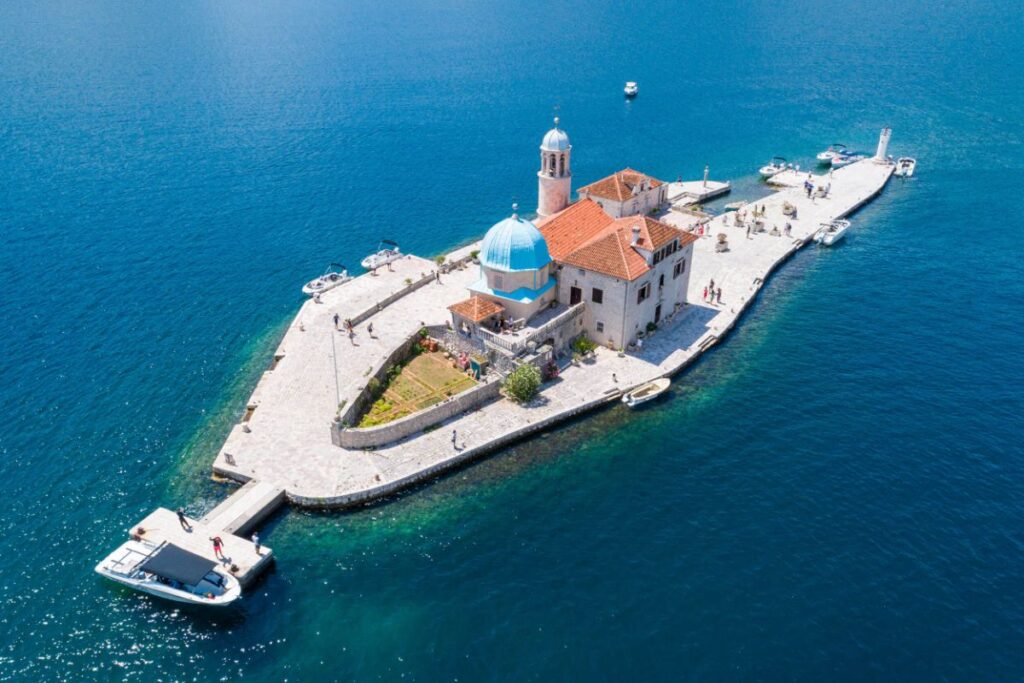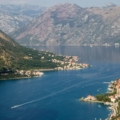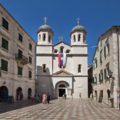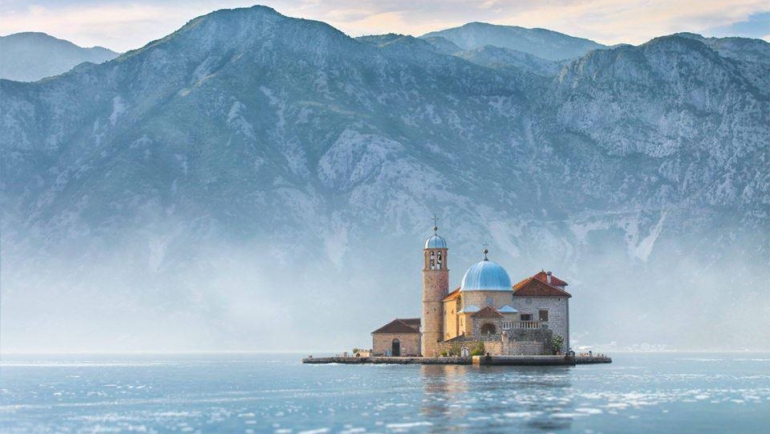
The Lady of the Rocks is a mysterious artificial island located in the Boka Bay of the Adriatic Sea off the coast of Montenegro. The island has long been a source of fascination for locals and visitors alike. The exact origins and timeline of this island remain shrouded in mystery, with various myths and legends surrounding its existence. Many stories tell of miraculous occurrences that resulted in the formation of the island, such as two large rocks emerging from the sea or mermaids creating it using sand brought up from beneath. Regardless of their origin, these tales have been passed down through generations and continue to be shared today with tourists and children all around the world.
In a heartwarming tale from the history of Lady of The Rock, two seafaring brothers from Perast, known as the Mortičić siblings, play a central role. As the story goes, upon their return from a fishing trip, the brothers were taken aback to discover an image of a lady, thought to be the Virgin Mary, gracefully positioned on a petite reef amidst the sea, situated right opposite their beloved hometown.
Intrigued by what they had seen, they took the image with them and returned home. The following day, they were out fishing again and were amazed to see the same image of Lady on the same reef. Believing it to be a sign from above, the brothers decided to build a church on the reef in honor of Lady. This is believed to be the origin of Lady of The Rock. The story is a testament to the deep religious faith of the people of Perast and their reverence for Lady. This is one of many myths and legends from Montenegro which bring a sense of wonder about some of its great locations.
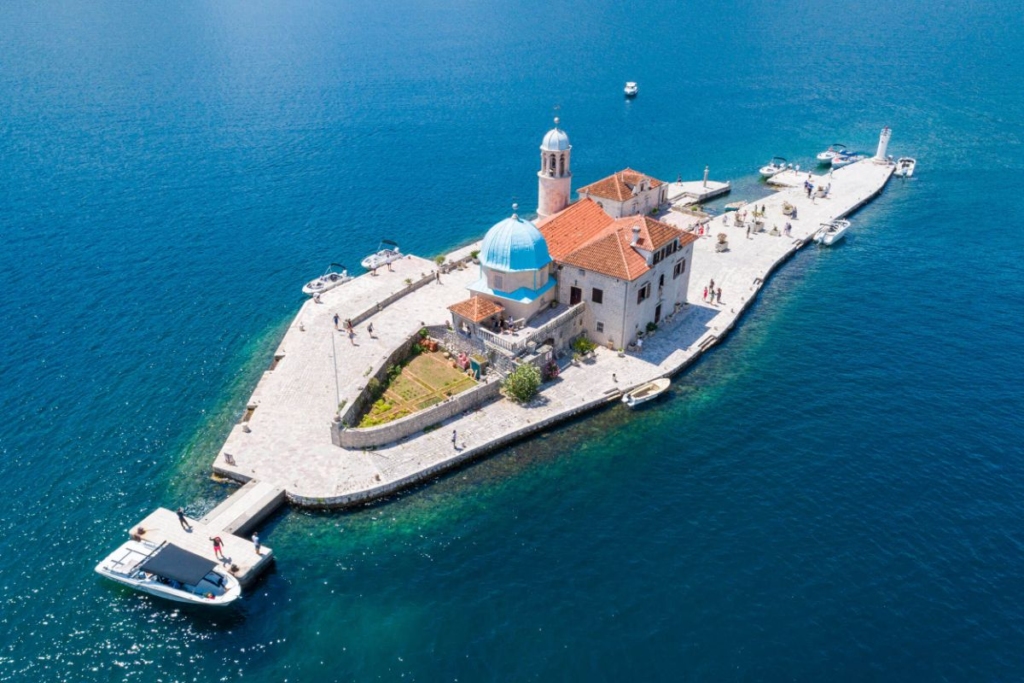
Introduction to the Lady of the Rocks
The Lady of the Rocks is an island located in Montenegro, close to Perast. It is one of the most beautiful and picturesque islands in all of Europe. The island was formed by a combination of natural forces and human ingenuity over centuries, with its unique shape being attributed to a naturally occurring phenomenon called ‘karstification’.
Origin of Lady of the Rocks
Our Lady of the Rocks stands as a cherished attraction in Montenegro, its formation attributed to the gradual erosion of limestone due to persistent contact with seawater. This natural phenomenon led to the creation of the island’s distinctive hollows and caves, later filled with sediment. Local tales further enrich the island’s history, speaking of two fishermen from Perast who, as legend has it, cast stones into the sea. Miraculously, these stones are said to have merged, giving rise to the island. While the authenticity of this tale remains a mystery, it undeniably enhances the charm of Our Lady of the Rocks, making it a must-visit spot in Montenegro.
In the tradition of Fashinada, a centuries-old custom, the people of Perast have been piling up stones and sinking dilapidated barges and Turkish ships around a small reef in the Bay of Kotor. Over time, this process has caused the surface of the reef to expand, and it now covers an area of about three thousand square meters. On this expanded surface sits the church of Our Lady of the Rocks, a beautiful and historic building that draws visitors from all over the world. Today, this beloved destination is revered by both locals and tourists who come to witness the island’s breathtaking beauty and learn more about its incredible story.
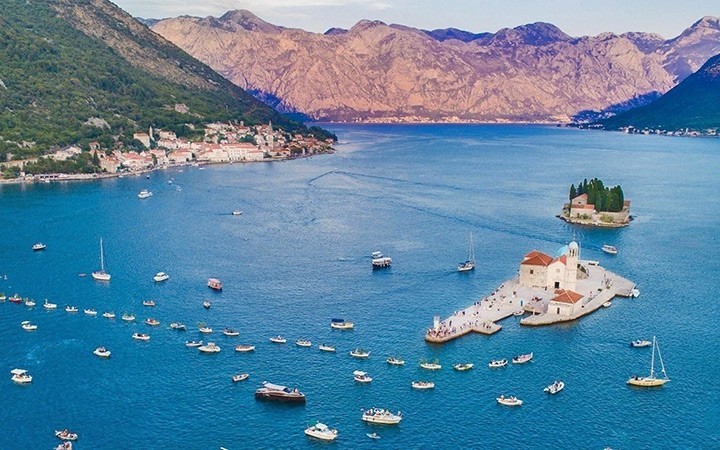
In times gone by, sailors would often pledge their devotion to Our Lady of the Rocks before setting out on their extensive and treacherous journeys. They vowed to express their gratitude should they return unharmed from their global expeditions. This deep reverence for Our Lady of the Rocks is evident in historical maps showcasing ships named in her honor, indicating her widespread recognition not just in Boka Bay but along the entire coastline. Remarkably, since the 16th century, there exist about 150 such maps.
Originally, these sailors committed to creating an island and offering a donation. Subsequently, they built a church on this island as a symbol of their promise, continually enhancing it with each new pledge they made during their voyages. Upon their safe return, they presented Our Lady of the Rocks with gifts from distant lands, including precious items like Chinese vases, porcelain, gold, and silver, as heartfelt tokens of their thankfulness. This enduring tradition underscores the profound bond sailors shared with Our Lady of the Rocks and the distinctive ways they chose to convey their appreciation.

Lady of the Rocks Monastery
Today, Our Lady of the Rocks is home to a vast treasure trove of priceless artifacts that were given as votive offerings to express gratitude to the Lady for her protection during long journeys or assistance in recovering from illnesses. Each of these votive offerings and silver plates, which were even more valuable than gold during that time, carries a unique narrative about a person’s future.
The Lady of the Rocks Monastery houses a vast array of religious artifacts and art pieces that are sure to captivate visitors. The most renowned attraction within the monastery is the collection of 68 oil paintings by local baroque artist Tripo Kokolja. These magnificent works of art depict scenes from the lives of Jesus Christ and the Virgin Mary.
In addition to the paintings, visitors can also admire the impressive iconostasis, a wall of icons and religious paintings that serves as the visual centerpiece of Orthodox Christian worship. Moreover, there is a famous votive tapestry on display, gifted to the monastery by the Venetian Republic in gratitude for the successful defense of the bay from pirates. The tapestry is considered one of the finest examples of textile art in the region. Lastly, visitors can marvel at a collection of silver votive tablets, which were left by grateful sailors who were saved from shipwrecks by the intercession of the Virgin Mary.
With its rich collection of art and artifacts, the Lady of the Rocks Monastery could easily be considered a museum of Italian artists in Montenegro. It is a must-visit destination for anyone interested in art, history, and spirituality.
One of the most impressive and interesting votive gifts was left to the church by Jacinta Kunić Mijović from Perast. She spent 25 years embroidering a picture of the upper portion of the main altar of the church with gold and silver threads and strands of her hair, featuring an image of the Holy Virgin covered with a silver chain. Her work is an exquisite and elaborate testament to her devotion to Our Lady of the Rocks and is a cherished part of the island’s vast collection of votive offerings. These artifacts are not only priceless in terms of their monetary value but also have immense cultural and historical significance as a tangible representation of the deep spiritual connections between the people of Perast and Our Lady of the Rocks.

Ceremonies and Celebrations
Our Lady of the Rocks is a beloved destination for both locals and tourists, who are drawn to its stunning natural beauty and the small church that stands on the island. Throughout the year, pilgrims visit the site on special occasions such as Easter Sunday and other festivals, seeking divine intervention and solace.
For centuries, Montenegrins have regarded this sacred site as an important pilgrimage destination, and it continues to hold spiritual significance to this day. The traditional celebrations that take place at Our Lady of the Rocks are deeply rooted in Montenegrin culture. Every July 22, local families gather here to celebrate St. Elijah’s Day, which has been observed since 1452, when Venetian sailors first visited the site. This celebration honors Saint Elijah, who is said to have lived in isolation on the island and performed many good deeds during his lifetime, such as healing people and providing food during famines.
July 22nd is an important date for the Lady of the Rocks Monastery as it marks the Feast of the Virgin Mary’s assumption into heaven, which is celebrated as the monastery’s patron saint day. On this day, the monastery holds a special mass, known as the “fasinada” ceremony, which involves locals in boats throwing rocks into the sea around the island as a way of continuing the tradition of adding stones to the artificial island.
The ceremony is followed by a procession of boats around the island, with passengers throwing more stones into the sea as a tribute to the Virgin Mary. The Feast of the Assumption is a significant event in the Roman Catholic Church and is celebrated by various cultures around the world, but the Lady of the Rocks Monastery’s unique fasinada ceremony makes it a particularly special celebration in the Boka Bay region.
Visitors to the island during the festival can witness beautiful boat races around the bay and participate in festive activities such as eating delicious seafood dishes and joining in folk dances. This event has become a much-loved tradition with significant cultural importance within Montenegro’s history and identity.
Despite storms and difficulties over the centuries, Our Lady of the Rocks has persevered thanks to the dedication of Perast’s residents. The island has come to represent eternity, faith, and gratitude, and its magnificence serves as a symbol of the enduring beauty and resilience of Perast and Boka in front of the Mediterranean.
How do I visit Lady of the Rocks
The Our Lady of the Rocks island and church is usually open to visitors during the day from early morning until late afternoon, with specific opening hours varying depending on the season. During peak tourist season, which typically runs from May to September, the island and church are generally open from 9:00am to 6:00pm or later. During the off-season months, the hours of operation may be shorter, with the island and church typically closing earlier in the afternoon. It’s recommended to check the official website or contact local tour companies for the most up-to-date information on the island’s opening hours.
To visit Our Lady of the Rocks, visitors can take a boat tour from the nearby town of Perast, which is located on the Bay of Kotor in Montenegro. Many local tour companies offer daily tours to the island, which typically include a guided tour of the small church and the island’s vast collection of votive offerings. During the tour, visitors can also learn about the island’s history, culture, and significance as a sacred pilgrimage site. The boat tour is a scenic and enjoyable way to reach Our Lady of the Rocks, as it allows visitors to take in the stunning natural beauty of the Bay of Kotor and the surrounding mountains.
The cost of visiting Our Lady of the Rocks can vary depending on the tour company and package chosen. On average, a boat tour from Perast to the island can range from 10 to 20 euros per person, depending on the duration and included services. Some tours may also offer additional activities, such as swimming in the crystal-clear waters surrounding the island or visiting nearby attractions, which can add to the cost. It’s recommended to check with local tour companies for their current prices and offerings.

